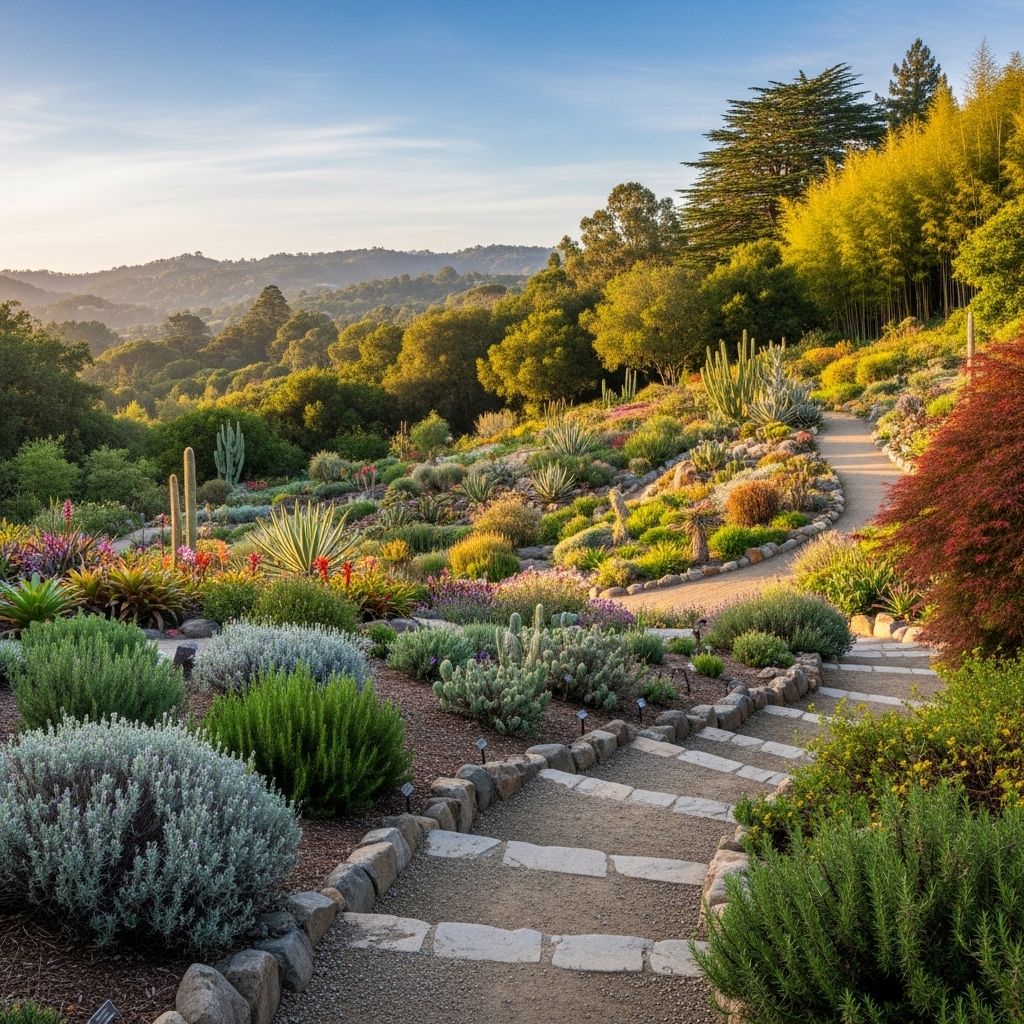UC Botanical Garden Berkeley: Explore 9 Regional Collections
Vibrant paths reveal plant diversity from redwoods to desert blooms.

Garden Visit: University of California Botanical Garden, Berkeley
The University of California Botanical Garden at Berkeley stands as a living museum, tucked into the scenic Berkeley Hills. Established in 1890 and spanning 34 remarkable acres, the garden boasts more than 10,000 different plant species sourced from nearly every continent, making it one of the world’s most diverse plant collections. Whether you’re a plant enthusiast, a student, or a casual visitor, a journey through this lush landscape offers an inspiring blend of education, exploration, and ecological wonder.
Table of Contents
- Introduction
- Garden Layout & Regional Collections
- California Natives: A Living Showcase
- Global Plant Regions: From Africa to Australasia
- Specialized Gardens & Greenhouses
- Research, Conservation & Education
- Visitor Experience & Amenities
- Frequently Asked Questions
Introduction: A Living Museum in the Hills
Commanding sweeping views of the San Francisco Bay, the UC Botanical Garden’s setting is as captivating as its collections. The gardens are arranged to display plant communities by geographic origin, enabling visitors to take a global botanical journey in just a few hours. With habitats ranging from fog-kissed redwood forests to sun-baked deserts, the garden is a refuge for both rare and common species, including many endangered plants vital to conservation efforts. As part of UC Berkeley, the garden is deeply integrated into research, conservation, and public education, serving as a valuable resource for the campus and the wider community.
Garden Layout & Regional Collections
The UC Botanical Garden is ingeniously organized into nine major geographical regions, each simulating native landscapes by replicating distinctive climates and topographies. As you follow the winding paths—often shaded by majestic coast redwoods—you traverse continents, climates, and cultures. Geographic divisions include:
- Southern Africa
- Asia
- Australasia
- South America
- Mediterranean Basin
- Mexico & Central America (Mesoamerica)
- Eastern North America
- California
- Deserts of the Americas
Within this framework, countless microhabitats offer surprises at every turn: alpine fell fields, serpentine outcrops, vernal pools, and chaparral slopes. Special collections—like the Chinese medicinal herb garden and rare plant areas—complement these major zones.
California Natives: A Living Showcase
The California section—arguably the heart of the Botanical Garden—features more than 1,200 species of native plants, including many endemic and endangered species found nowhere else. This impressive display recreates the state’s most characteristic plant communities, providing an immersive overview of California’s botanical beauty.
- Redwood Forests: Towering coast redwoods form sun-dappled glades reminiscent of old-growth forests along the California coast.
- Mediterranean Chaparral: Hardy shrubs and aromatic herbs typify this fire-adapted landscape.
- Serpentine Soils Garden: Showcases plants adapted to California’s unusual, nutrient-poor serpentine soils.
- Alpine Fell Fields & Vernal Pools: Recreate high-altitude habitats and seasonal wetland meadows, critical for rare wildflowers.
- Pygmy Forest: Features dwarfed conifers and shrubs adapted to nutrient-deficient environments.
- Berkeley Hills Flora: Beds dedicated to local natives, especially the distinctive oaks of the region.
Plant highlights include over 100 manzanita species, nearly 80 kinds of California lilac, over 100 types of native bulbs (such as Fritillaria and Calochortus), numerous annual wildflowers like the California poppy, and rare plants such as vine hill clarkia. Interpretive signs and plant labels provide valuable educational context, making this area a hub for botanical study and inspiration.
Global Plant Regions: From Africa to Australasia
Beyond California, the UC Botanical Garden’s international regions allow you to encounter ecosystems from every corner of the world—each artfully designed to evoke the look, feel, and aroma of their native habitats.
Southern Africa
Just inside the entrance, you’re greeted by Southern Africa’s rich and dramatic flora, including aloe, protea, and unique bulbs. Spring brings vibrant wildflower displays that recall the famed blooms of Namaqualand.
Asia
The Asian section features iconic trees and shrubs: magnolias, maples, camellias, and rhododendrons; rare and medicinal plants from China and Japan; and tranquil shaded areas lined with bamboo and ornamental cherries. The Chinese Medicinal Herb Garden presents a selection of plants from the Chinese pharmacopeia, reflecting both traditional and modern uses.
Australasia
In Australasia, experience the strange forms of Australian eucalyptus, acacias, and banksias, as well as unusual plants from New Zealand’s islands—such as tree ferns and alpine species adapted to the region’s unique climate.
South America
The South American grove holds monkey puzzle trees (Araucaria araucana), lush fuchsias, southern beeches, and rare vines like Lapageria. The area illustrates the amazing biodiversity of the Andes and Patagonian forests.
Mediterranean Basin
This hillside features aromatic herbs and shrubs native to the Mediterranean rim, from Morocco and Spain to Syria and Turkey. Olives, lavender, and rockroses fill this sunlit area, with sweeping views across the San Francisco Bay.
Mesoamerica (Mexico & Central America)
Diversity abounds in the Mesoamerican section—fiery salvias, agaves, yuccas, oaks, and pines punctuate the landscape. These plants thrive in both mountain and desert climates, demonstrating Central America’s ecological variety.
Eastern North America
This zone celebrates the great deciduous forests with tulip trees, dogwoods, bald cypress, and woodland wildflowers, showcasing a contrast to California’s native flora.
Deserts of the Americas
Experience the bristling cacti and succulents of North, Central, and South American deserts. This exhibit highlights the incredible adaptations plants have evolved to survive intense aridity and temperature extremes.
Specialized Gardens & Greenhouses
The UC Botanical Garden is home to several unique specialty gardens, as well as an extraordinary array of greenhouses that shelter some of the garden’s most fascinating—and fragile—plants.
- Chinese Medicinal Herb Garden: A curated collection demonstrating the role of plants in traditional and modern medicine.
- Herb and Edible Plant Collection: Culinary and medicinal species from around the world.
- Arid House: Seasonal displays of rare and exotic cacti and succulents, including “living stones” (Lithops).
- Fern and Carnivorous Plant House: Diverse ferns and remarkable insect-eating plants adapted to low-nutrient soils.
- Tropical House: Recently renovated, housing tropical species of economic and ecological significance—including coffee, cacao, and the formidable corpse lily (Amorphophallus).
Throughout the garden, interpretive signage helps visitors understand how plants fit into ecological systems and human society, offering lessons in ethnobotany, evolutionary biology, and horticulture.
Research, Conservation & Education
As a core part of UC Berkeley’s scientific mission, the Botanical Garden serves as a living laboratory for ongoing research and conservation initiatives.
- Biodiversity Conservation: The garden is instrumental in the preservation of globally endangered species through ex situ collections and seed-banking, helping protect genetic diversity and support species reintroduction.
- Scientific Research: The plant collections underpin a range of research, from evolutionary biology and climate adaptation to ethnobotany and conservation ecology.
- Education: Programs and classes for all ages foster appreciation for plants and their essential role in healthy ecosystems. Children, university students, and adult learners alike participate in tours, workshops, and lectures designed to illuminate the complexities of plant life and conservation.
- Community Engagement: Public events, lectures, and partnerships expand environmental literacy and connect visitors to the importance of sustaining biodiversity.
Conservation and research efforts at the garden reflect a broader mission: sustaining the partnership between humans and the plant world for future generations.
Visitor Experience & Amenities
The garden’s thoughtful design, interpretive features, and amenities make it a welcoming destination for all visitors.
- Trails & Paths: Easily navigated winding paths lead through shaded glades and sunlit slopes, with plenty of benches and lawns for rest and relaxation.
- Panoramic Views: Vistas extend over the Bay Area, enhancing the sense of escape and tranquility.
- Accessibility: Main paths and key exhibits are accessible to visitors with mobility limitations.
- Events & Classes: The garden offers a full slate of events—lectures, workshops, tours, and family-friendly programming.
- Gift Shop & Plant Nursery: Take part of the garden home with a collection of rare and interesting plants, botanical-themed gifts, books, and local crafts. The plant nursery offers seasonal sales of specimens well-suited for Bay Area gardens.
- Event Rentals: The historic Julia Morgan Hall and Redwood Grove Amphitheater are available for weddings and special gatherings surrounded by nature’s beauty.
With every season, the botanical garden transforms—spring wildflowers, summer shady retreats, autumn foliage, and winter blooms provide year-round interest. Interpretive maps and seasonal bloom guides help visitors plan their explorations for maximum enjoyment.
Frequently Asked Questions (FAQs)
Q: How many plant species are in the UC Botanical Garden?
A: The garden is home to over 10,000 different kinds of plants, with more than 13,000 living specimens collected from around the world, many of which are rare or endangered.
Q: What makes the California collection special?
A: The California area comprises more than 1,200 native species, including rare and endemic plants. It recreates several distinct habitat types—like redwood forests, vernal pools, and chaparral slopes—not typically seen together outside the wild.
Q: Are there plants from every continent?
A: The garden features plants from every continent except Antarctica, including distinct sections for Africa, Asia, Australasia, the Americas, and the Mediterranean region.
Q: What educational opportunities are available?
A: The garden provides hands-on classes, family programs, research opportunities, guided tours, and public lectures related to botany, conservation, and horticulture, serving both the university and the public.
Q: Can I host private events in the garden?
A: Yes. Spaces such as the Redwood Grove Amphitheater and Julia Morgan Hall are available for weddings, corporate functions, and private gatherings, offering unique settings surrounded by natural beauty.
Q: What is the best time of year to visit?
A: Every season offers something different—spring for wildflowers, summer for Mediterranean blooms and shady retreats, fall for foliage, and winter for unique blooms in the greenhouses.
Q: Is there an admission fee?
A: Yes, a modest admission fee supports garden operations and programming, though special events and memberships may offer free or discounted entry privileges.
Final Thoughts: A Sanctuary for Plants, People, and Discovery
The University of California Botanical Garden at Berkeley is more than a showcase for world flora—it is a community resource, a conservation stronghold, and a reminder of the essential partnership between humans and the plant kingdom. Its winding paths, rare collections, and educational mission invite every visitor to pause, explore, and reflect on the Earth’s biodiversity.
Plan a visit to experience the global journey from redwoods to rare succulents, from shaded glades to sun-washed slopes—right in the heart of Berkeley.
References
- https://en.wikipedia.org/wiki/University_of_California_Botanical_Garden
- https://www.visitcalifornia.com/experience/uc-botanical-garden-berkeley/
- https://bringingbackthenatives.net/university-of-california-botanical-garden-at-berkeley
- https://botanicalgarden.berkeley.edu/about/
- https://botanicalgarden.berkeley.edu
Read full bio of Anjali Sayee












